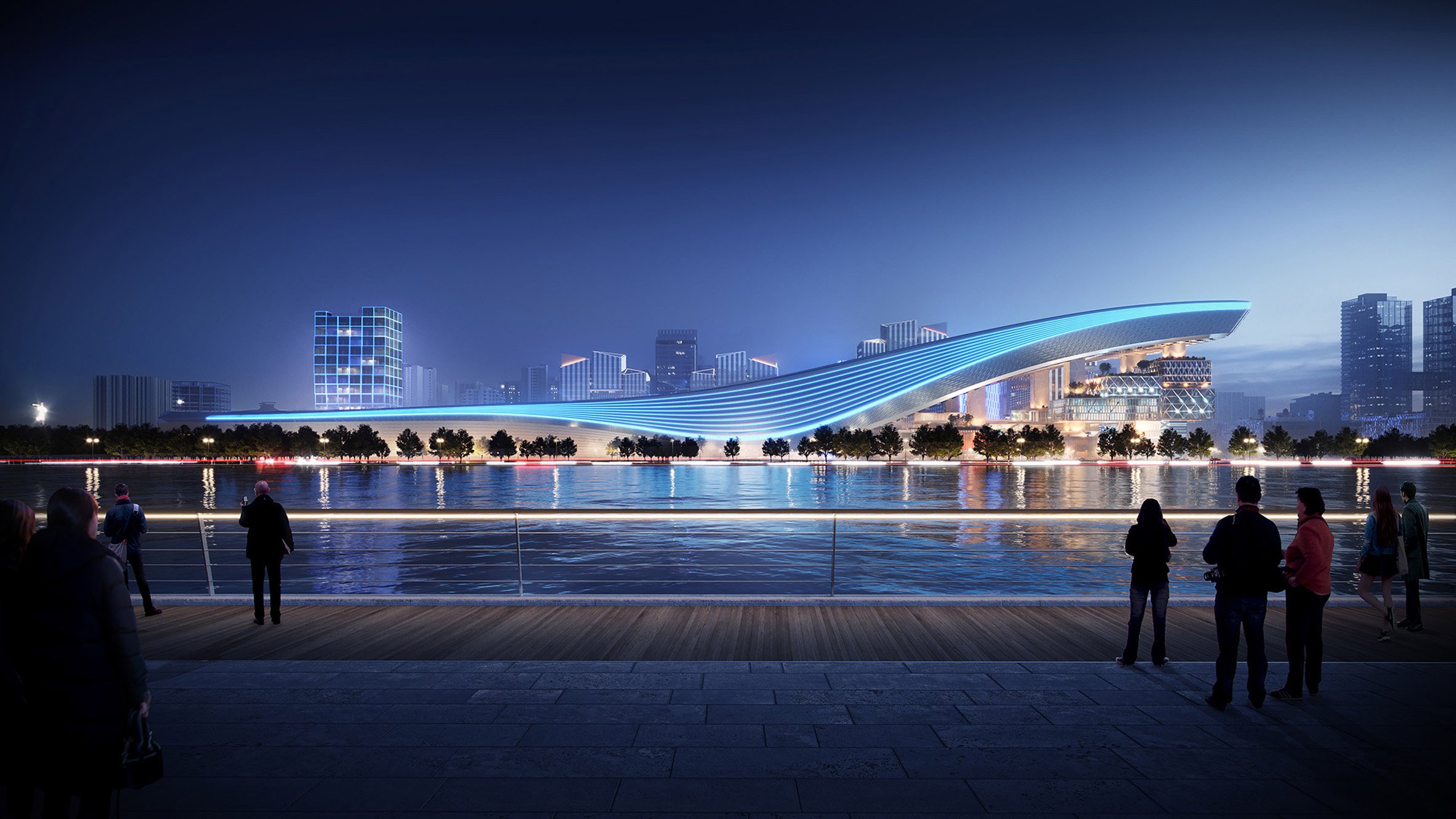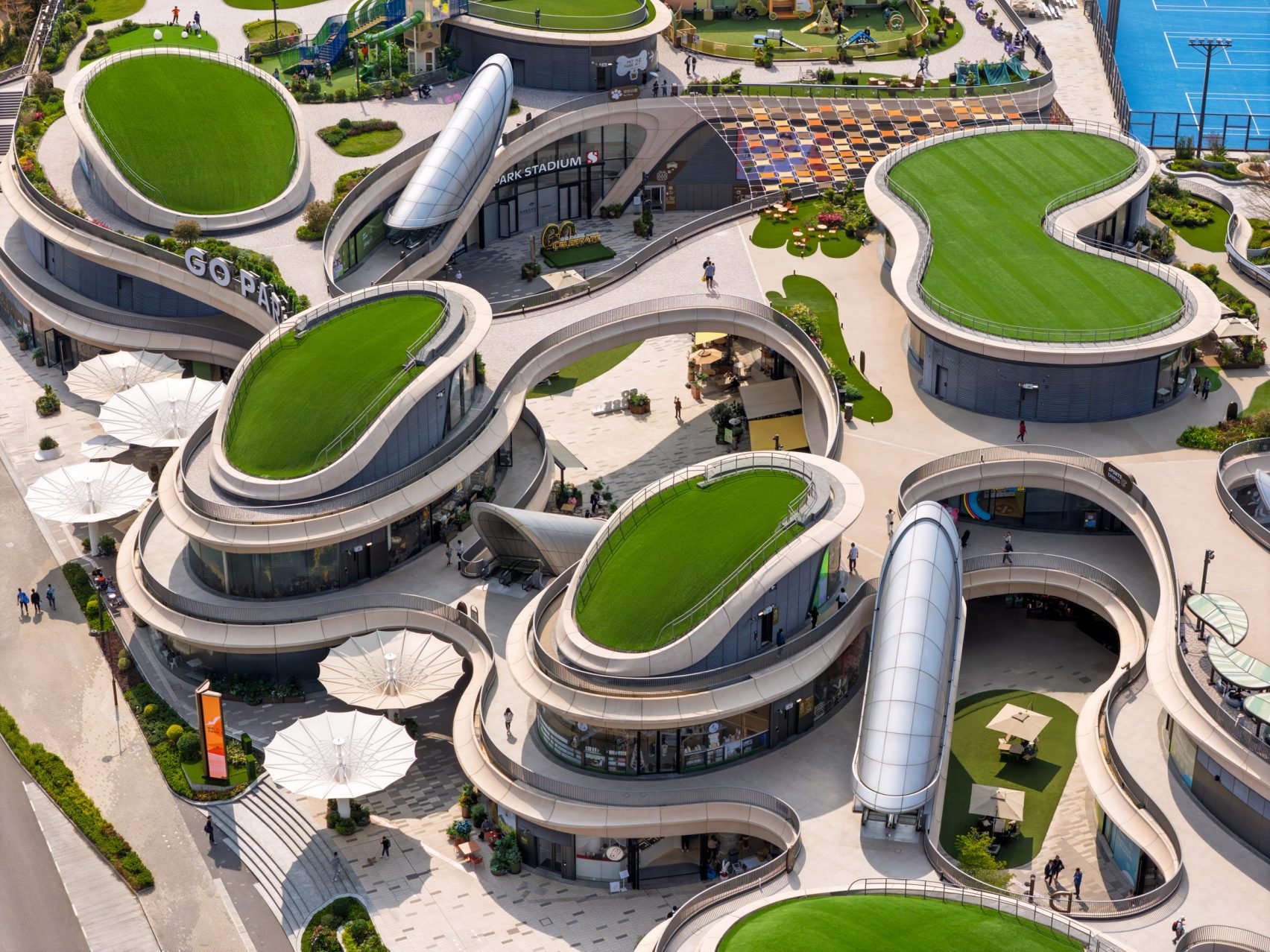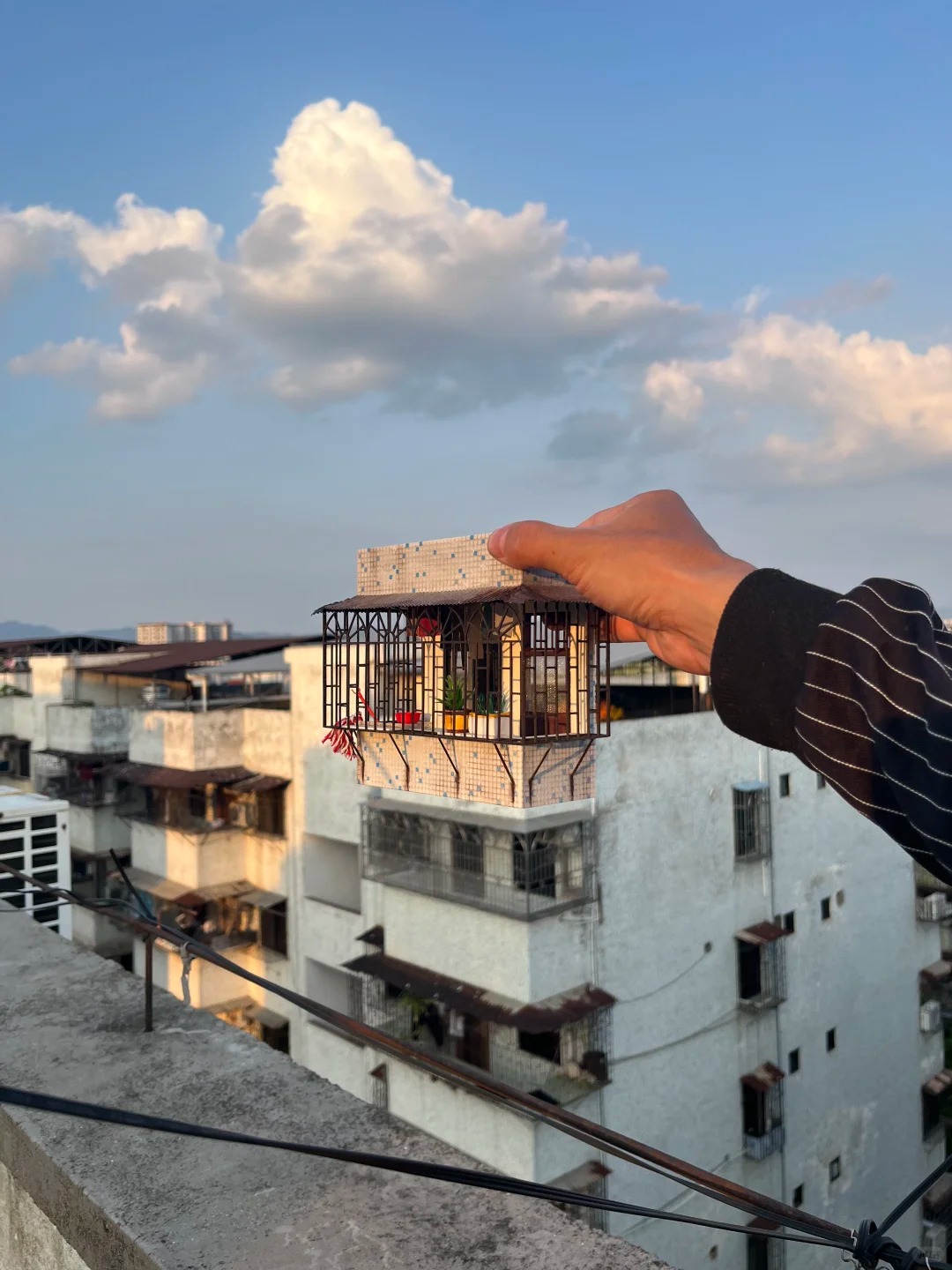Building China is a monthly series on RADII in which Lauren Teixeira examines China’s built environment, placing some of the features of Chinese architecture into their socio-political context.
For the last couple of months here at Building China we’ve been talking about superblocks: what they are, how they came to be, and why they’re bad.
[To fully catch up, start here and find part two here.]
To recap, a superblock — in the Chinese context at least — is a large (anywhere from 400 to 800 meters square) plot of urban land filled with residential towers and bounded by arterial roads on all four sides. Chinese superblocks are typically gated at each entrance and often but not always enclosed by a wall or fence. Both Chinese and Western urbanists argue that superblocks are bad for society (they enact segregation) and for the environment (the resulting coarse urban grain means you have to drive a car to get anywhere).

Worker Unit-style housing (pink buildings in foreground) surrounded by new developments, and a golf course, in Tianjin (© Bonandbon DW | Dreamstime.com)
Despite these well-known issues, China adopted superblock planning with unprecedented zeal and on an unprecedented scale throughout the ’90s, 2000s and most of this decade. Only very recently have the pleas of the global planning community come to be reflected in urban policy. In 2016, the State Council issued a set of guidelines that seemed remarkably aligned with best practices in contemporary urban planning: in the hundred-plus page document, the Council recommends constructing smaller blocks, ending gated residential compounds, and opening up existing blocks for better connectivity while building more bike lanes and pedestrian paths.
After the guidelines were released, a number of articles in the Western press wondered if China was finally adopting the New Urbanism — a set of principles based around small blocks, walkability and mixed-use neighborhoods that are the mainstream in Western planning today.
Related:
 Building China: Rise of the SuperblockHow China came to repeat the urban development mistakes of the US and Europe, resulting in colossal building projects and car-centric livingArticle Mar 04, 2019
Building China: Rise of the SuperblockHow China came to repeat the urban development mistakes of the US and Europe, resulting in colossal building projects and car-centric livingArticle Mar 04, 2019
Of course, anyone even glancingly familiar with contemporary China knows that impressive sounding high-level policies such as these rarely find expression in reality. More often than not, such initiatives are ignored or twisted by local officials eager to cover their own asses while burnishing political credentials.
So against that back-drop, let’s take a look at our prospects for rectifying the Chinese superblock!
Fixing the Superblock
Broadly, attempts to rectify the superblock can be broken up into two categories: newly built and relatively unpopulated superblocks in newly established districts or cities; and older, densely populated superblocks in established urban areas. So far, efforts have been concentrated almost entirely in the former category. The reasoning is intuitive: because these areas have fewer people and buildings, it’s much less hassle to cut back into the blocks with new roads, bike paths etc.
The outstanding example here has to be Chenggong, a planned satellite city of Kunming launched in 2003 that drew attention throughout the aughts as one of China’s most prominent “ghost towns.” With massive boulevards and little infrastructure, the city was empty as people found it inconvenient to live there.
WSJ: Ghost city of Chenggong, near Kunming (Wait – I heard nobody cld find real ghost cities!)http://t.co/QqdxO8BXcS pic.twitter.com/QZ5rwxaRN8
— Patrick Chovanec (@prchovanec) July 15, 2014
Then, earlier this decade, a number of cities including Kunming started working with Calthorpe Associates — the firm of leading New Urbanist Ian Calthorpe, who I mentioned in my first column — to reform selected areas (typically newly built “eco cities” or “new cities” like Chenggong) through road network densification and urban infill.
A recent column by Wang Chen in China Dialogue is tentatively optimistic about the results in Chenggong, where the core road network now boasts a density of 11.83 kilometer of road per square kilometer, putting it on par with Chicago or Barcelona (the average road density of major Chinese cities is much lower — if you really want to geek out I highly recommend this report by China’s academy of social sciences, which quantifies and visualizes the road network of each provincial capital).

Can you guess which city this is? (image: from aforementioned report)
In the China Dialogue piece, Wang quotes a Chenggong resident called Zhou who moved from Beijing to Chenggong two years ago:
“Some say Chenggong is an empty town but that was in the past. The town is really good now and it feels like a modernised Western town. First of all, there is never congestion and the public transport system is convenient. It also has fresh air and great infrastructure.“
This is indeed encouraging to hear. However, Chenggong and similar projects like Yuelai eco-city in Chongqing (also a Calthorpe), Binhai New Area in Tianjin, and Meixi Lake in Changsha, all share a major shortcoming: they’re small scale, expensive (and not eco-friendly) to build and confined to populations of affluent people. In this way they’re reminiscent of New Urbanism projects in the US, which have tended to be focused on small planned towns rather than existing urban superblocks. (Seaside, Florida is the typical example.)
And herein lies what I think is the most trenchant critique of the New Urbanism: the movement is inherently resistant to the messy business of working and compromising with the imperfect built environment. For the principles laid out in the 2016 guidelines to have any kind of large scale social or environmental impact, New Urbanism must be more than a boutique project reliant on fancy foreign consultants.
Learning from Chenggong
China must be able to take to heart the lessons from Chenggong and apply them to the decidedly less sexy task of reforming tens of thousands of the superblocks monotonously encircling the cores of China’s major cities.
A daunting task, to be sure (especially when you think of all the mianzi — 面子 “face” — that will have to be forgone by local officials who would rather be building shiny eco-cities). At the same time, this kind of project seems possible nowhere if not China. After all, China loves nothing more than a large scale engineering project; nor has it historically had too much compunction about displacing people and tearing up existing urban fabric. Furthermore, there’s lots of empty ground area in China’s superblocks because of how widely buildings have been spaced to maximize southern solar exposure. This provides a lot of potential for infill with shops, roads and green spaces.

The image on the left, from Steven Gajer’s masters’ thesis on the Chinese superblock, shows a model of a typical Chinese superblock followed by Gajer’s adapted model with added low and high rise buildings plus additional streets cutting through the block for better connectivity:
Looks pretty simple, right? Unfortunately, I think it’s unlikely we’ll ever see something like this materialize. My main reason for saying this is that it’s been 3 years since these guidelines were issued and my research (on Chinese and western internet as well as anecdotal — don’t have the resources to do a longitudinal survey, sorry) has not unearthed any instances of a superblock actually being opened up.
Running into Traffic
This is hardly surprising. When the guidelines were issued in 2016, they elicited a largely negative response from the Chinese public, which expressed concerns about safety, property values and noise — and this was in reaction to just the prospect of opening the compound gates to let cars through, not even adding in more buildings for retail and residence. You can find a good rundown of the controversy from Xinhua here (link in Chinese). Spooked by the outpouring from China’s de facto “voters” — middle class homeowners — the Housing Bureau issued another statement a few days later clarifying that the changes would be very gradual and no “knife” would be taken to the closed superblocks.

Plan for rectifying the Sanlinyuan compound in Shanghai. Source: Redesigning China’s superblock neighbourhoods: policies, opportunities and challenges (Kan, Forsyth and Rowe)
As this Journal of Urban Design report on redesigning the superblock notes, at the heart of this controversy is a discourse around cars and vehicular traffic. The whole thing so far has been framed as an issue of alleviating traffic, rather than emphasizing social good or the environmental benefit, which is not that inspiring and in some cases a negative thing — who wants cars invading their peaceful compound?
If it were up to me I would focus on opening up the superblocks first with pedestrian and bike paths, which would at least make China’s superblock suburbs slightly more bearable for non-motorists. But this still brings up thorny issues of property rights and zoning, as the report points out. Since the roads and green spaces inside of commodity housing estates are currently jointly owned by the homeowners, the conversion to public space would require the consent of a whole battery of stakeholders.
The authors of the report give the example of Sanlinyuan compound in Shanghai. Theoretically, opening those superblocks would involve “attaining a consensus across more than 2,000 households, any interventions would also entail engaging the Sanlin Residents’ Committee, the Sanlin Community, and the Pudong New Area Planning and Land Authority.” Here you may object that it’s China and things like rights and laws don’t actually matter. But again, middle class homeowners are still the demographic bloc the Party cares about appeasing, and they can be pretty fierce, as we saw in the protests that erupted in 2017 in Shanghai, which saw homeowners take to the streets over new housing regulations.

Shanghai roads (photo by Denys Nevozhai on Unsplash)
For now, then, I think we can expect the closed superblocks to remain closed. Our best hope probably lies in new development in China’s megacities, which will keep growing for at least another few decades. If China can somehow manage to encourage smaller block construction in these new areas, it would at least be a step in the right direction.
Previously on superblocks in China:
 Building China: Rise of the SuperblockHow China came to repeat the urban development mistakes of the US and Europe, resulting in colossal building projects and car-centric livingArticle Mar 04, 2019
Building China: Rise of the SuperblockHow China came to repeat the urban development mistakes of the US and Europe, resulting in colossal building projects and car-centric livingArticle Mar 04, 2019
 Building China: Why Does Chinese Architecture Favor Enclosure Over Openness?Enclosure and gating are key aspects of Chinese architecture, but are Chinese people naturally predisposed to shutting themselves away?Article Apr 16, 2019
Building China: Why Does Chinese Architecture Favor Enclosure Over Openness?Enclosure and gating are key aspects of Chinese architecture, but are Chinese people naturally predisposed to shutting themselves away?Article Apr 16, 2019
Cover photo: xiaokang Zhang on Unsplash
















